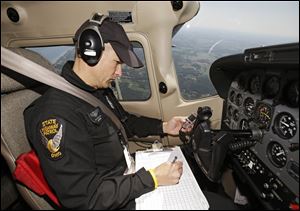
Ohio troopers nab speeders from sky
7/2/2012
Ohio Trooper Bryan Dail operates a stopwatch, records speeds on his clipboard, flies a pattern over a state highway, and gives directions to troopers on the ground.
NEW YORK -- Highway signs throughout New York warn that when it comes to catching speeders, the long arm of the law extends even into the sky. "State Police aircraft used in speed enforcement," they say.
Actually, lead-footed drivers hitting the interstates for the Independence Day holiday can keep their eyes on the road.
The New York State Police, who once routinely used planes to clock motorists, haven't written a single ticket in that manner since at least 2005.
"It hasn't been entirely eliminated," Sgt. Kern Swoboda, a state police spokesman, said of the signs. "We still have the airplanes."
But in these budget-conscious times, he said, launching aircraft to catch speeders isn't fiscally prudent.
New York is one of several states to scale back the use of aircraft for traffic enforcement in recent years because of budget cuts or concerns about cost-effectiveness.
Planes are still getting a big workout nabbing speeders in Ohio and Florida.
Last year, the Ohio Highway Patrol said it issued more than 16,000 speeding tickets based on aircraft observations, down only a little from a five-year high of 18,000 written in 2009.
Over the Memorial Day weekend, the start of the busy summer travel season, the agency had 10 aircraft in the air doing traffic enforcement, said Lt. Randy Boggs, the unit's commander.
The Toledo Police Department also does aerial speed enforcement three to four times a year, with most campaigns focused on southbound I-75 in North Toledo, said Sgt. Joe Heffernan, a department spokesman.
"That seems to be where we have the most trouble," he said, noting the I-75 campaigns typically yield 100 tickets during a shift, and one recent blitz included three tickets written for speeds exceeding 100 mph.
The police department uses an airplane flown by one of two licensed pilots on the police force, the sergeant said.
Florida's Highway Patrol has eight aircraft and eight pilots, who issue about 30,000 citations yearly, said the patrol's chief pilot, Capt. Matthew Walker. He said he hadn't suffered budget cuts.
When done right, air patrols have distinct advantages, Lieutenant Boggs and Captain Walker insisted.
From the air, it's easier to see the ultraaggressive drivers who change lanes erratically, follow too close, and pose the greatest hazard on the road.
Officers on the ground don't have to race around for miles to spot violations.
"It's very efficient," Lieutenant Boggs said.
Ohio tries to keep down the cost of flights by flying smaller planes and having the pilot clock drivers, rather than use a second spotter.
Lieutenant Boggs pegged the fuel and maintenance cost of flying at $111 an hour.
Typically, aerial enforcement programs involve a plane, a pilot, a spotter to time vehicles as they travel between lines painted on the road, and several cruisers to pull people over and issue tickets.
"That ain't cheap," New York's Sergeant Swoboda said. He added that updated laser technology now allows a trooper on the ground to get speed readings over long distances and in heavy traffic -- two situations where aircraft used to be superior.
"So what better way to do it than have three guys at a median crossover?" Sergeant Swoboda said.
"We found that it was far more efficient and a lot less expensive."
In many places where speed enforcement by aircraft has tapered off, law enforcement air wings have remained busy conducting surveillance, tracking crime suspects, searching for missing people, and spotting marijuana farms from the air.